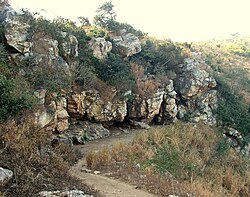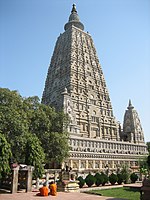Saptaparni Cave
| Saptaparni Cave | |
|---|---|
 Saptaparni Cave | |
| Location | Rajgir, Bihar |
| Coordinates | 25°00′26″N 85°24′39″E / 25.007175°N 85.410792°ECoordinates: 25°00′26″N 85°24′39″E / 25.007175°N 85.410792°E |
| Governing body | Archeological Survey of India |
Saptparni Cave, also referred to as Sapta parni guha (Saraiki) or sattapaṇṇi guhā (Pali), literally Seven-leaves-cave (cognate with sapta, sept), is a Buddhist cave site about 2 kilometres (1.2 mi) southwest from Rajgir, Bihar, India.[1][2] It is embedded in a hill. The Saptaparni Cave is important in the Buddhist tradition, because many believe it to be the site in which Buddha spent some time before his death,[3] and where the first Buddhist council was held after Buddha died (paranirvana).[1][4][5] It is here that a council of few hundred monks decided to appoint Ananda, Buddha's cousin, and Upali, who had accompanied the Buddha when he gave sermons in north India, to compose Buddha's teachings for the future generations. This was of special importance because the Buddha never wrote down his teachings. After the meeting in Saptaparni Cave, Ananda created an oral tradition of Buddha's teaching from his memory, prefacing it with "Thus have I heard on one occasion". Upali is credited with reciting the Vinaya (discipline), or "rules for the Bhikshus".[1] This tradition is found in Vinaya Pitaka II.284 through II.287 and Digha Nikaya II.154.[6]
References[edit]
- ↑ 1.0 1.1 1.2 Paul Gwynne (30 May 2017). World Religions in Practice: A Comparative Introduction. Wiley. pp. 51–52. ISBN 978-1-118-97228-1.
- ↑ Jules Barthélemy Saint-Hilaire (1914). The Buddha and His Religion. Trübner. pp. 376–377.
- ↑ Digha Nikaya 16, Maha-Parinibbana Sutta, Last Days of the Buddha, Buddhist Publication Society
- ↑ Kailash Chand Jain (1991). Lord Mahāvīra and His Times. Motilal Banarsidass. p. 66. ISBN 978-81-208-0805-8.
- ↑ Chakrabartia, Dilip K (1976). "Rājagriha: An early historic site in East India". World Archaeology. 7 (3): 261–268. doi:10.1080/00438243.1976.9979639.
- ↑ Peter Harvey (2013). An Introduction to Buddhism: Teachings, History and Practices. Cambridge University Press. pp. 88–89. ISBN 978-0-521-85942-4.
- Caves of Bihar
- Buddhist caves in India
- Buddhist sites in Bihar
- Caves containing pictograms in India
- Maurya Empire
- History of Bihar
- Indian rock-cut architecture
- Nalanda district
- Archaeological sites in Bihar
- Buddhist monasteries in India
- Buddhist pilgrimage sites in India
- 5th century BC in India
- 4th century BC in India
- 4th-century BC establishments in India
- Former populated places in India
- Tourist attractions in Nalanda district
- Buddhism stubs
- Bihar geography stubs


